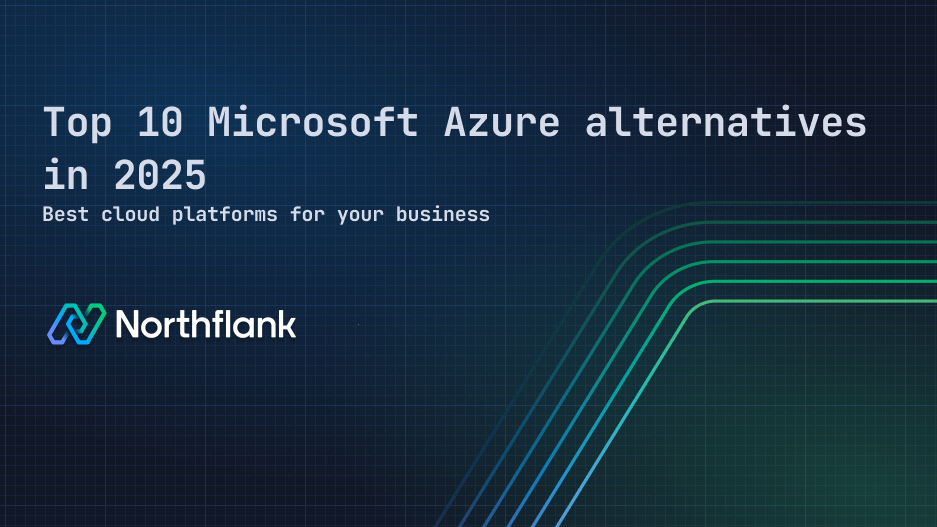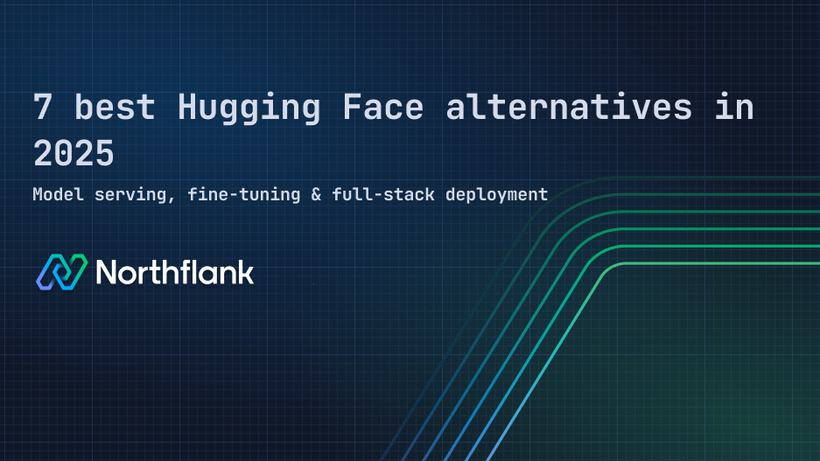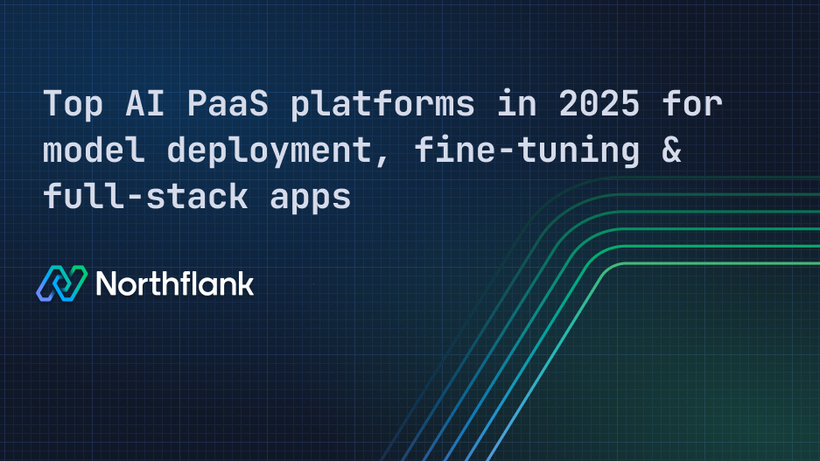

Top 10 Microsoft Azure alternatives in 2025: Best cloud platforms for your business
With so many developers and businesses searching for cloud provider alternatives every day, it’s clear that cloud solutions are no longer a one-size-fits-all, especially when it comes to Azure alternatives.
Isn’t it surprising how, even with so many options out there, it’s still hard to find the one that suits your needs? I totally get it. That’s why we put this guide together to help you find an Azure alternative that matches what you're looking for.
At the same time, we can’t ignore the fact that Azure has its strengths. Even at that, the confusing pricing, overwhelming complexity, and the feeling of being stuck in one ecosystem have pushed many businesses like yours to search for something different. If any of this rings a bell, keep reading.
For context, this article focuses mainly on alternatives to Azure App Service, which is the part of Azure that lets you host, run, and scale web apps. If you’re using it and want something simpler, faster, or more flexible, this should help.
See for yourself how a cloud platform can provide more control, flexibility, and support as you scale. With affordable pricing, free-tier options, and pay-as-you-go models, you can avoid vendor lock-in and choose a solution that fits your business needs.
If you're short on time, here's a quick overview of 10 Azure alternatives based on key factors like BYOC support, global infrastructure, pricing, and target audience. This table gives you a snapshot to help you compare and decide quickly.
| Cloud provider | BYOC (Bring Your Own Cloud) support | Global infrastructure | Pricing | Target audience |
|---|---|---|---|---|
| Northflank | Yes | Global, region-aware | Transparent, scalable (Free tier, pay-as-you-go) | Developers, startups, SMBs, enterprises, DevOps teams |
| Railway | No | Global | Usage-based with $5/month minimum | Developers, Startups |
| Fly.io | No | Global (30+ regions) | Pay-as-you-go | Developers, SMBs |
| Render | No | Global | Free tier, then fixed pricing | Developers, SMBs |
| Harness | No | Global | Modular, per-developer pricing | Enterprises, DevOps |
| Porter | Yes | Global | Metered billing (startup credits available) | Developers, SMBs |
| OpenShift | No | Global | Subscription-based | Enterprises, Kubernetes |
| AWS App Runner | No | Global | Pay-as-you-go | Developers, Enterprises |
| Google Cloud Run | No | Global | Pay-as-you-go | Developers, Enterprises |
| Vercel | No | Global | Free tier, then fixed pricing | Front-end developers |
The decision to choose the right (most suitable) option from the many Azure alternatives available online is about more than finding something cheaper; cost has been a very popular discussion, especially on Reddit:

So, what’s it really about, then, you might ask? It comes down to choosing a platform that can answer a few key questions:
- Does it fit your specific needs?
- Can it scale with your business?
- Does it integrate smoothly with what you’re already using?
- … what else can you think of? Add more to the list…
Now that you know, let’s quickly go over what you should keep in mind when making this choice. You’ll see a breakdown of the key factors to help guide your decision:
How many times have you received an unexpected cloud bill? It can catch you off guard, right? Look for alternatives that make pricing clear and easy to understand. You want to know what you’ll be paying upfront, not get hit with hidden or unpredictable costs.
A platform with transparent pricing, or even a cost calculator like the one Northflank provides on the pricing page, will help you stay in control of your budget.
Compared to Azure’s calculator, which makes you piece together dozens of services and understand SKUs, Northflank’s is built to be fast and simple. You can input what you want to run, get a full cost breakdown in seconds, and avoid decoding complex billing layers.
Try it here to see how the calculator works:

How much freedom do you want with your cloud strategy?
With BYOC, which means Bring Your Own Cloud, or multicloud support, you can take control by choosing the best cloud environment for your needs. This means you can deploy directly into your own GCP, AWS, Azure, Civo, and OCI accounts.

Platforms like Northflank provide BYOC features that allow you to deploy your applications on your preferred cloud provider or even your bare-metal infrastructure for more control and customization.
If you need to understand BYOC better, read this article.
As your business grows, your cloud needs will change, that’s a fact, right?. Now the question is, can your platform grow with you?
A good Azure alternative should be able to scale quickly and easily as your requirements expand. It doesn't matter if you're handling more traffic, adding services, or expanding globally; make sure your platform grows at the same pace as your business.
Solutions like Northflank make scalability simple. You can easily scale your applications with just a few clicks, even if you need to scale instances vertically or horizontally, or automatically adjust your resources based on demand. The autoscaling feature helps you stay in control and ensures your applications remain responsive even as traffic increases.

So, if you're used to worrying about downtime or performance issues, solutions like Northflank that support the scaling of both stateless and stateful workloads should definitely be on your radar.
To try this out yourself, check the guide on auto-scaling your deployments.
You don’t want to start from scratch when switching platforms, right? So, it’s important to find an alternative that works well with the tools you already use. It could be your CI/CD pipeline, database, or other software. The platform should make your work easier and not more complicated. Look for integrations that help keep your workflow organized and running smoothly.
An Azure alternative like Northflank makes this entire process simple. For instance, integrating your Azure account with Northflank is easy. You can follow step-by-step guides to register your Azure Active Directory application, link it to Northflank, and manage your cloud resources effortlessly.

Now that we’ve covered what to look for in an Azure alternative, let’s go into some of the best options available.
Northflank is a cloud platform built for developers and teams who want to focus on building and scaling applications without worrying about infrastructure management.
It provides BYOC (Bring Your Own Cloud) support and multicloud flexibility, allowing you to deploy on your preferred cloud environment or even bare-metal infrastructure.
It also provides features such as autoscaling, transparent pricing, and easy integrations with tools like GitHub and Docker.

If your needs or problems are:
-
“I need my apps to scale automatically without worrying about cost”
Northflank takes care of both with autoscaling features that adjust resources based on demand. The pricing calculator helps you stay within budget by showing what you’ll pay before you deploy.
-
“I need flexibility to deploy on my cloud provider or on bare-metal”
Northflank’s BYOC and multicloud support let you choose your cloud environment, providing full control over your infrastructure.
-
“I need predictable, simple pricing”
Northflank provides transparent pricing, including a free tier to help you get started and pay-as-you-go options as you grow.
-
“I am tired of being locked into one cloud provider”
Northflank solves this by letting you bring your own cloud, giving you the flexibility to choose the best environment for your needs.
-
“I don’t want to deal with managing infrastructure”
Northflank’s managed cloud feature allows you to deploy apps without handling the setup yourself. Once deployed, you can easily manage your clusters from one place.
Railway is a cloud platform built for developers who want a fast, straightforward way to ship apps. It gives you flexibility to manage configuration through code, using railway.toml or railway.json files, so you can control how apps are built and deployed.
It also provides built-in integrations and environment management to simplify app deployment directly from your GitHub repo.

If your needs or problems are:
-
“I need a quick, easy deployment process”
Railway makes it simple to deploy from your repository with minimal setup. You can launch apps in just a few steps.
-
“I want to avoid managing infrastructure myself”
Railway handles servers and infrastructure for you behind the scenes, so you can focus on writing and shipping code.
-
“I’m comparing options beyond Railway and Azure”
If you're unsure if Railway is the right fit for your long-term needs, check out this article on Railway alternatives to see what other platforms can meet your goals.
Fly.io is a cloud platform that allows developers to deploy applications close to users by running them on servers located in over 30 regions worldwide. It gives a developer-friendly experience with features like autoscaling, private networking, and a global edge network.
It also supports both autostop/autostart and metrics-based autoscaling, allowing applications to scale based on demand or custom metrics.

If your needs or problems are**:**
-
“I need to deploy my app close to users globally”
Fly.io's global network allows you to run your applications in multiple regions, reducing latency and improving performance.
-
“I want my app to scale automatically based on demand”
Fly.io gives you both autostop/autostart and metrics-based autoscaling options, which allow your application to adjust resources dynamically in response to traffic or custom metrics.
-
“I’m checking for more alternatives to Fly.io”
If you're looking at other options, this Fly.io alternatives article is helpful for comparing different platforms.
Render is a unified cloud platform designed to simplify the deployment and management of web applications, APIs, static sites, and databases.
It provides features like one-click deployments, automatic scaling, and integrated CI/CD pipelines, enabling developers to focus on building applications without worrying about infrastructure management.

If your needs or problems are:
-
“I need automatic scaling based on traffic”
Render provides autoscaling capabilities that adjust the number of service instances based on traffic patterns, ensuring optimal performance without manual intervention.
-
“I want a straightforward deployment process”
With Render's one-click deployments and integrated CI/CD pipelines, you can deploy your applications quickly and efficiently, reducing the time from development to production.
-
“I’m looking for more alternatives to Render”
If you're considering other options, this Render alternatives article is helpful for comparing different platforms.
Harness is a comprehensive software delivery platform built to support the entire DevOps lifecycle. It includes modular tools for continuous integration, continuous delivery, feature flag management, chaos engineering, and cloud cost optimization.
It also comes with smart automation, robust security features, and helpful data to speed up how teams ship software.

If your needs or problems are:
-
“I need a platform that supports intelligent autoscaling”
Harness enables autoscaling through its Delegate system, allowing for resource scaling based on CPU and memory utilization. This helps keep deployments running smoothly without downtime or resource overload.
-
“I prefer a flexible pricing model that scales with my team”
Harness offers a Developer 360 subscription model with Free, Startup, and Enterprise plans. This per-developer pricing structure allows teams to select and pay for only the modules they need, providing predictability and scalability as your organization grows.
-
“I’m looking for more alternatives to Harness”
If you're looking for other options, this article on Harness alternatives might help you compare different platforms.
Porter is a PaaS (Platform-as-a-Service) designed to help teams deploy and manage applications on their own cloud infrastructure using Kubernetes without the complexity that usually comes with it.
It provides a Heroku-style developer experience while letting you run everything in your AWS or GCP account.

If your needs or problems are:
-
“I want a Heroku-like platform but with more control”
Porter gives you that familiar Heroku-style UI and workflow, but behind the scenes, it deploys your apps directly into your own AWS or GCP infrastructure, giving you more control and flexibility.
-
“Kubernetes is too complicated to manage”
Porter abstracts Kubernetes behind an easy-to-use interface. You don’t need to write Helm charts or deal with raw manifests; it automates the Kubernetes setup for you.
-
“I’m still weighing my options”
If you’re comparing Porter with other platforms, this article on Porter alternatives provides a complete view.
OpenShift is Red Hat’s enterprise-grade Kubernetes platform designed to help teams build, deploy, and manage containerized applications at scale.
It provides self-managed and fully managed options, including OpenShift Dedicated, Azure Red Hat OpenShift, and Red Hat OpenShift Service on AWS (ROSA), providing flexibility across hybrid and multi-cloud environments.

If your needs or problems are:
-
“I need a platform that supports automatic scaling”
OpenShift provides both Horizontal Pod Autoscaling (HPA) and Cluster Autoscaling. HPA adjusts the number of pod replicas based on CPU or memory usage, while Cluster Autoscaler adds or removes nodes to meet workload demands.
-
“I want to deploy across hybrid or multicloud environments”
OpenShift supports deployments on various infrastructures, including AWS, Azure, Google Cloud, IBM Cloud, and on-premises data centers, providing flexibility for diverse deployment strategies.
-
“I’m looking for more alternatives to OpenShift”
If you're considering other options, this article on OpenShift alternatives might help you compare different platforms.
AWS App Runner is a fully managed service that simplifies the process of deploying containerized web applications and APIs directly from source code or container images.
It automatically handles the infrastructure, including provisioning, scaling, and load balancing, allowing developers to focus on building applications without managing servers.

If your needs or problems are:
-
“I want my applications to scale automatically based on demand”
App Runner provides configurable auto-scaling settings, allowing you to define parameters like maximum concurrency, minimum, and maximum instance counts. This helps your application scale in a way that matches changing traffic without overprovisioning or lag.
-
“I need a straightforward deployment process from my code repository”
With App Runner, you can set up automatic deployments that trigger whenever you push new code to your repository. This continuous deployment capability makes the release process faster and easier to manage.
-
“I’m looking for more alternatives to AWS App Runner”
If you're looking for other options, you might find this AWS App Runner alternatives article helpful for comparing different platforms.
Google Cloud Run is a fully managed serverless platform that allows you to deploy and run containerized applications without managing infrastructure.
It automatically scales your applications up or down based on traffic, even down to zero when not in use, helping to optimize costs.

If your needs or problems are:
-
“I need my applications to scale automatically based on demand”
Cloud Run supports request-based autoscaling, automatically adjusting the number of container instances to handle incoming requests as they come in. This helps your application respond to changes in traffic without needing manual adjustments.
-
“I want a straightforward deployment process from my code repository”
With Cloud Run, you can deploy applications directly from your source code or container images. It integrates easily with popular CI/CD tools, enabling continuous deployment workflows.
-
“I prefer a pay-as-you-go pricing model”
Cloud Run operates on a pay-as-you-go pricing model, charging you only for the resources your application uses.
-
“I’m looking for more alternatives to Google Cloud Run”
If you're looking for other options, you might find this Google Cloud Run alternatives article helpful for comparing different platforms.
Vercel is a frontend-focused platform tailored for developers who are building with modern frameworks like Next.js, React, and Svelte.
It simplifies the deployment process by including automatic CI/CD, serverless functions, and a global edge network that helps maintain fast load times and scale as needed.

If your needs or problems are:
-
“I want my applications to scale automatically based on demand”
Vercel provides automatic scaling by deploying applications across its global edge network, helping maintain optimal performance during traffic spikes without manual intervention.
-
“I need a straightforward deployment process from my code repository”
Vercel connects easily with Git repositories, so every push triggers an automatic deployment. This helps keep the development workflow clear and straightforward.
-
“I’m looking for more alternatives to Vercel”
If you're looking for other options, this Vercel alternatives article might help you compare different platforms.
Still trying to figure things out? That’s totally normal. Below are some common questions people have when comparing Azure with other cloud platforms, along with quick answers to help you get clarity.
-
What is an alternative to Azure?
An alternative to Azure is any cloud platform that provides similar services, such as hosting, scaling, and deploying applications. Examples include Northflank, AWS, Google Cloud, Render, and others.
-
Who competes with Microsoft Azure?
Azure's biggest competitors are Amazon Web Services (AWS) and Google Cloud Platform ****(GCP). Other growing platforms like Northflank, Render, and Fly.io also compete in specific areas, especially with developer-first features.
-
What replaced Azure?
Azure hasn’t been replaced, but many teams are moving away from it in favor of platforms that provide more flexibility, clearer pricing, and simpler setup.
-
Why is AWS better than Azure?
AWS has been around longer and generally provides more services and documentation. Some developers also find AWS’s ecosystem easier to use and better supported by third-party tools.
-
Is Azure still relevant?
Yes, Azure is still widely used, especially by companies already using Microsoft tools. But more teams are now choosing alternatives that give them more control and less complexity.
-
Is Azure better than Google Cloud?
It depends on your needs. Azure works well with Microsoft’s stack. Google Cloud is often preferred for its tools around data and machine learning. Both are popular, but not always the best fit for every team.
Now that you’ve seen what each platform can do, the next step is figuring out which one fits best with your goals. The right cloud platform isn’t always the one with the most features. It’s the one that gives you what you need, without adding extra complexity.
A few things to keep in mind as you decide:
- Know what you want control over (pricing, infrastructure, or both)
- Check if the platform works with your current tools and setup
- Look for transparent pricing (a free tier helps too)
- See how much freedom you have to scale or switch providers
- Make sure the docs and support are easy to access
If you're trying to see how a developer-first platform with transparent pricing, autoscaling, and multi-cloud support can fit into your workflow, see how it works for teams like yours.

